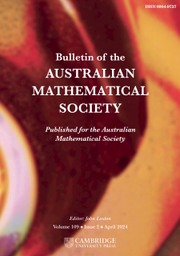No CrossRef data available.
Article contents
AN EFFECTIVE VERSION OF THE PRIMITIVE ELEMENT THEOREM
Published online by Cambridge University Press: 13 October 2025
Abstract
Let K be an infinite field. If  $\alpha $ and
$\alpha $ and  $\beta $ are algebraic and separable elements over K, then by the primitive element theorem, it is well known that
$\beta $ are algebraic and separable elements over K, then by the primitive element theorem, it is well known that  $\alpha +u\beta $ is a primitive element for
$\alpha +u\beta $ is a primitive element for  $K(\alpha , \beta )$ for all but finitely many elements
$K(\alpha , \beta )$ for all but finitely many elements  $u\in K$. If we let
$u\in K$. If we let  $$ \begin{align*}\xi_K(\alpha, \beta) = \{u\in K : K(\alpha, \beta) \ne K(\alpha+u\beta)\}\end{align*} $$
$$ \begin{align*}\xi_K(\alpha, \beta) = \{u\in K : K(\alpha, \beta) \ne K(\alpha+u\beta)\}\end{align*} $$
be the exceptional set, then by the primitive element theorem,  $|\xi _K(\alpha , \beta )| < \infty $. Dubickas [‘An effective version of the primitive element theorem’, Indian J. Pure Appl. Math. 53(3) (2022), 720–726] estimated the size of this set when
$|\xi _K(\alpha , \beta )| < \infty $. Dubickas [‘An effective version of the primitive element theorem’, Indian J. Pure Appl. Math. 53(3) (2022), 720–726] estimated the size of this set when  $K = \mathbb {Q}$. We take K to be a finite extension over
$K = \mathbb {Q}$. We take K to be a finite extension over  $\mathbb {Q}$ or
$\mathbb {Q}$ or  $\mathbb {Q}_p$, the field of p-adic numbers for some prime p, and estimate the size of the exceptional set.
$\mathbb {Q}_p$, the field of p-adic numbers for some prime p, and estimate the size of the exceptional set.
MSC classification
Information
- Type
- Research Article
- Information
- Copyright
- © The Author(s), 2025. Published by Cambridge University Press on behalf of Australian Mathematical Publishing Association Inc.


